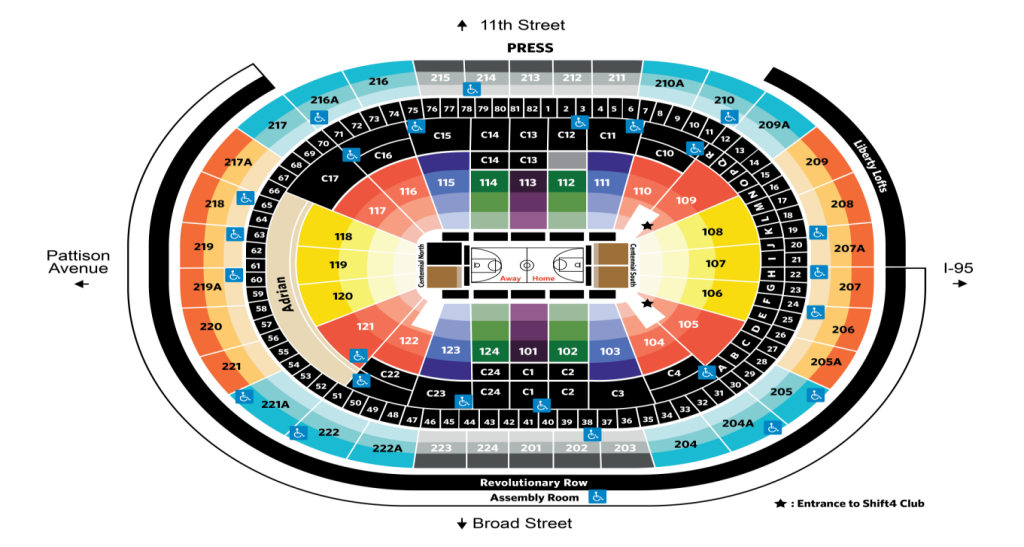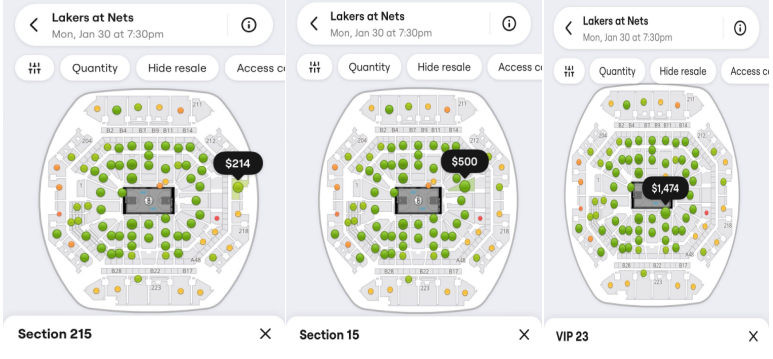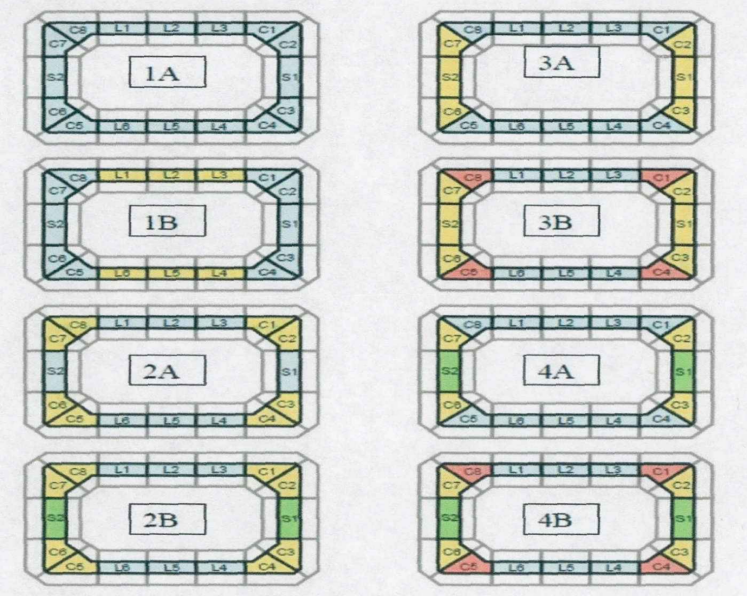1. Introduction
The global sports industry is thriving, and the United States is the global leader in professional sports development and innovation. Despite the effects of the financial crisis, the growth of the country's professional sports venues has remained a focal point of attention, making the study of stadiums in the United States an invaluable resource. The cost of construction and the return on investment once the stadium is completed have always been at the forefront of the media's and sports economists' attention when discussing the site selection of professional sports stadiums in the United States. After construction and opening, the stadium will benefit greatly from reasonable ticket pricing. It is clear that the cost of admission is a major consideration for both the stadium and the fans when deciding where to build or, later, when the stadium is renovated. In the same way that ticket prices are the most important link in the stadium's marketing plan, they are also the link that allows the audience and the stadium to communicate with one another. Because the point of stadium advertising is to get people to buy tickets so they can watch the game, and so generate more money for the local economy. Ticket prices have become a connecting factor because spectators at a game must purchase entry in order to enter the stadium. Since ticket prices have such a profound impact on stadium attendance and revenue, studying and analyzing these factors is of paramount importance. The paper, through a method of literature review and analysis, explores how the NBA teams price their tickets. It hopes to provide some useful suggestions for the industries in this field.
2. Characteristics of Venue Interiors Related to Ticket Pricing
Understanding the internal structural characteristics of arenas that are closely related to ticket pricing is an important first step in researching arena ticket prices. This chapter will present the internal building characteristics of an NBA arena and how they affect pricing [1], drawing from the relevant arena design literature as well as actual NBA arena construction blueprints.
2.1. Number of Seats in the Venue
It can be said that the number of seats in the stadium is the internal structure of the stadium with the characteristics of the closest connection with the ticket pricing, as different seats in the stadium determine different ticket pricing, and the number of seats will also directly determine the size of the total ticket revenue.
While it is true that professional stadiums need to have ample seating for all of their fans, it is also true that too many seats would be unnecessary and wasteful. When the home team wins, the stadium's capacity fills up and things get tense because there's more demand for seats than there are available. As a result, the price of admission goes up, on the one hand, to generate more money and, on the other, to limit the number of people who can attend games there. Arena operations aim to strike a balance between supply and demand, so it's important to think about how many seats will actually be needed before construction begins. This will help ensure that there aren't too many empty seats on nights when the home team doesn't perform well or there isn't a game at all. Loss of money from tickets sold in addition to wasted floor space, building costs, and operating expenses is the result of unsold seats. As you can see, the total number of seats is dependent on the stadium's capacity for high attendance, which gives the impression to the audience that "the arena is very popular" and, in turn, can bring in more income for the arena. Average and weighted sums reveal the following about NBA venue seating for the 2007-08 season: Total arena seating capacity is calculated to be 19,197 using arithmetic mean and weighted average [1].
2.2. Premium Seating
In terms of suites, boxes and club seating represent the upper echelons of a venue's ticket revenue pyramid and generate significantly more revenue per seat than more affordable general admission sections.
When it comes to club seating, NBA arenas typically have two levels, with the club section placed either below the suites or in the midst of the two levels of boxes [2]. Club seating is an arena section that offers a more intimate experience, with access to premium services and facilities. Club sections have access to amenities such as check-in desks staffed by staff, private entrances and hallways, bars, and private ordering services. The Wells Fargo Center is where the Philadelphia 76ers play their home games (figure 1).

Figure 1: Wells Fargo Center [3].
The aforementioned data study of NBA arena interior construction elements and ticket prices led to the following results. First, the NBA arena's interior is built on a distinct system with a distinct pulse and a distinct purpose. The venue capacity is set according to the number of expected spectators. Second, the NBA arena's indoor construction serves a wider variety of purposes, making it suitable for a wider range of spectators. Third, tickets to NBA games are priced in accordance with the meticulous and fair design of the arena's seating.
3. Characterization of Ticket Pricing
3.1. Ticket Prices vs. Arena Seating
For the sake of argument, let's pretend that the entire arena is one seamless structure. CGF (Central Game Field) refers to the field in the center of the stadium where the action takes place. Assume the vertical and horizontal distance between any two circles of seats in the stadium to be constant, there is a negative correlation between seat distance and pricing at the CGF. Once the location of the Central Game Field (CGF) is established, the cost of a ticket increases the closer it is to the CGF and reduces as one moves up the rows, mirroring the variation in ground rent; conversely, the cost of a ticket decreases the farther it is from the CGF. Depending on their priorities, attendees must weigh ticket price against closeness to the CGF when selecting their seats. The audience will have to sacrifice a higher budget by paying less for tickets and sitting further from the CGF. SeatGeek, one of the major U.S. ticket exchange systems, reports that ticket prices reflect this reality (Figure 2).

Figure2: Seatgeek’s ticket pricing for different locations [4].
3.2. NBA Common Pricing Case Studies

Figure 3: Eight different pricing strategies typically used by NBA arenas depending on seat location [1].
Figure 3 displays the distribution of ticket prices in NBA arenas, showing that a total of eight different pricing structures are employed on a regular basis. Of the 93% of NBA stadiums that used multiple pricing tiers, the vast majority (2B and 3B) were used for lower-level seats. Prices varied by venue, with the highest ones appearing in the front and the lowest ones at the back. The most popular pricing strategy for premium tiers was 3B (26%), followed by 4B (17%) and 4A (12%).
4. The Impact of Location on Ticket Pricing
It stands to reason that ticket prices would skyrocket if the arena were situated in a city with a small basketball market culture. The average price of a ticket to a Knicks game for a family of four is $936.72, up 4.2% from the 2020-21 season, as reported by Team Marketing Report's annual NBA Fan Cost Index research [5]. Their single general admission ticket is the costliest in the league at $186.3. The Warriors' 6.1 percent price increase, which is the equivalent of a $8.07 price jump, helped them surpass the Lakers as the team with the highest FCI this season at $740.08. The Lakers reported a $711.76 FCI, making them one of 18 teams that did not increase ticket prices. When compared to the Warriors' average ticket price of $139.49, the Lakers' ($143.67) was still more expensive [6]. There is little doubt that the New York Knicks' ticket prices are sky-high given that the team is based in Manhattan—the epicenter of American and global culture—and that the city itself commands a premium. Due to the high expense of running the stadium, land taxes, etc., fans in Lisle should expect to pay a premium for tickets. The Los Angeles Lakers, also based in Los Angeles, have the second-highest single-game ticket price, followed by the San Francisco-based Golden State Warriors. They are both from California, the state with the second-largest economy in the US and home to both teams. Tickets are expensive because of the teams' great players, such as Steph Curry and LeBron James, and the size of the local basketball market in which they play.
However, the Brooklyn Nets are a bit of an outlier. Despite being located in New York City, ticket prices are expected to rise to around $90 in 2021—significantly less than the New York Knicks [7]. Kevin Durant and Kyrie Irving are just two of their superstars that year. The New York Knicks don't have a stranglehold on the local basketball market by any means. How come their general admission ticket prices can be lower?
The writer believes this distinction between Brooklyn and Manhattan should be maintained because of their distinct physical locations. This means that the Brooklyn Nets have lower operating costs than other teams. A huge number of New Yorkers, especially those living in Manhattan, continue to view the Nets as a New Jersey franchise despite their relocation here. As a result, the Nets' fan base isn't very dedicated to the team, making them more price-sensitive when purchasing game tickets. The New York Knicks are the Bucks' primary competitor, and because the nets are evenly matched, they have to engage in a bidding war to attract fans. It remains to be seen, however, what other reasons contribute to the Bucks' substantially cheaper pricing than the Knicks'.
5. Discussion
The success of ticket pricing is, in part, determined by the typical fan's perception of whether or not ticket prices will rise. When comparing the average of the lowest ticket costs of arenas built or refurbished around 2007, the difference was found to be extremely modest when using the standardized ticket pricing of NBA venues for the 07-08 season. Average standard ticket prices before and after 2007 at each ballpark are compared, as are changes in these prices expressed as a percentage.
One obvious trend is an increase in price for select NBA game tickets. Ticket prices have gone up from rows 19-34, with the biggest jump occurring between rows 25 and 30, where the club seating is located. Rows 31–34, the first three rows of the upper deck, have also seen a price hike. Second, compared to an NBA arena constructed before 2007, prices in rows 5-9, 16-18, and 35-45 are discounted by 4-10% [8]. Considering that the media is more interested in the upper tier of seating in rows 34–35, it's likely that arena owners believe the additional revenue from rows 19–34 more than makes up for the price decreases in the other rows. Most of the rise in stadium revenue comes from premium seating, which is typically not very profitable in older stadiums (those built before 2007).
In this paper, the author summarizes several recommendations for some other arenas. First, price should be very market-driven for tickets.
As a first step, modern professional sports stadiums should establish a multi-dimensional overall marketing model with a seamless information loop for ticket pricing. This is because ticket prices should be set in accordance with the consumption levels of the target audience and the unique characteristics of the professional sports competitions that will be held in the stadium.
Secondly, in this age of varied consumer attitudes, it is important that the planning and design of ticket price take into account notions of humanization, customized service, and regional cultural peculiarities. Ticket prices should reflect the emotional investment fans have in their favorite professional teams and their identification with the local sports culture. Super-cheap consumerism and increased turnout are the direct results of applying this idea well.
Third, the use of up-to-date information technology and locations for a wide range of regional events should inform ticket prices as much as feasible.
Fourth, the marketing strategy for selling tickets should take into account the differences between the various venues as much as possible. We can identify the regional features of venue ticket marketing and the profit and loss point, as well as quickly identify and correct the blind spot and falling back trend of ticket sales by comparing the marketing systems of various venues. Long-term ticket profitability and high attendance is the most appealing competitive advantage of professional sports stadiums for the teams and fans of such teams. Ticket prices are also affected by the team's popularity and the strength of the local basketball market. This effect, however, is quite minor and requires additional research.
6. Conclusion
Ticket pricing plays a very important role in leverage, which is not only closely related to the venue's location, the characteristics of the internal structure of the venues, or the premise of calculating the venue's revenue, but also reflects the attendance rate, the audience's prefereces, and the other factors discussed in the previous chapters of the research. It is the central emblem of the market-oriented, information-based, scientific development of American professional sports arenas, and this can be seen in the analysis of ticket pricing methods, programs, systems, and financial indicators. It is imperative to have a deeper professional theoretical understanding of ticket pricing, more advanced integrated marketing tools, and the establishment of a more detailed database in order to ensure the key role of ticket pricing in the development of professional sports venues in the United States in light of the highly market-oriented and information-functionalized rapid development of such venues. If you want your ticket prices to be as relevant as possible to your venue's business, you'll need a thorough, methodical study conducted by a financial analysis team that has a firm grasp on the latest developments in sports marketing.
References
[1]. Peng Xiaoyi. An Analytical Study on Ticket Pricing of NBA/NHL Professional Stadiums in the United States[D]. Central China Normal University, 2011, 33-35.
[2]. Heather J. Lawrence.James Kahler. Ron T, Conton. An Examination of Luxury Suite Ownership in ProfessionaSports [M]. Elsevier, 2007, 101-102.
[3]. Seating Charts, 2022. https://www.wellsfargocenterphilly.com/assets/img/Updated-76ers-Seating-Chart-v7-copy-8f7e1aa8d1.png
[4]. Seat Geek, 2022. https://seatgeek.com/
[5]. The Economics of Sports Facilities and Their Communities [J] . John Siegfried,Andrew Zimbalist. The Journal of Economic Perspectives . 2000 (3).
[6]. Tactics used by sports organizations in the United States to increase ticket sales [J] . Dennis R. Howard,John L. Crompton. Managing Leisure . 2004 (2).
[7]. NBA Fan Cost Index of Team Marketing Report, 2022. https://teammarketing.com/fci/2021-22-nba-fan-cost-index/
[8]. Alder Almo, Knicks remain as most expensive NBA team to watch, 2022. https://empiresportsmedia.com/new-york-knicks/knicks-remain-as-most-expensive-nba-team-to-watch/#:~:text=According%20to%20Team%20Marketing%20Report%27s,single%20general%20ticket%20costing%20%24186.3
Cite this article
Yang,P. (2023). Analysis of the Tactics of NBA Pricing Tickets. Advances in Economics, Management and Political Sciences,44,8-13.
Data availability
The datasets used and/or analyzed during the current study will be available from the authors upon reasonable request.
Disclaimer/Publisher's Note
The statements, opinions and data contained in all publications are solely those of the individual author(s) and contributor(s) and not of EWA Publishing and/or the editor(s). EWA Publishing and/or the editor(s) disclaim responsibility for any injury to people or property resulting from any ideas, methods, instructions or products referred to in the content.
About volume
Volume title: Proceedings of the 7th International Conference on Economic Management and Green Development
© 2024 by the author(s). Licensee EWA Publishing, Oxford, UK. This article is an open access article distributed under the terms and
conditions of the Creative Commons Attribution (CC BY) license. Authors who
publish this series agree to the following terms:
1. Authors retain copyright and grant the series right of first publication with the work simultaneously licensed under a Creative Commons
Attribution License that allows others to share the work with an acknowledgment of the work's authorship and initial publication in this
series.
2. Authors are able to enter into separate, additional contractual arrangements for the non-exclusive distribution of the series's published
version of the work (e.g., post it to an institutional repository or publish it in a book), with an acknowledgment of its initial
publication in this series.
3. Authors are permitted and encouraged to post their work online (e.g., in institutional repositories or on their website) prior to and
during the submission process, as it can lead to productive exchanges, as well as earlier and greater citation of published work (See
Open access policy for details).
References
[1]. Peng Xiaoyi. An Analytical Study on Ticket Pricing of NBA/NHL Professional Stadiums in the United States[D]. Central China Normal University, 2011, 33-35.
[2]. Heather J. Lawrence.James Kahler. Ron T, Conton. An Examination of Luxury Suite Ownership in ProfessionaSports [M]. Elsevier, 2007, 101-102.
[3]. Seating Charts, 2022. https://www.wellsfargocenterphilly.com/assets/img/Updated-76ers-Seating-Chart-v7-copy-8f7e1aa8d1.png
[4]. Seat Geek, 2022. https://seatgeek.com/
[5]. The Economics of Sports Facilities and Their Communities [J] . John Siegfried,Andrew Zimbalist. The Journal of Economic Perspectives . 2000 (3).
[6]. Tactics used by sports organizations in the United States to increase ticket sales [J] . Dennis R. Howard,John L. Crompton. Managing Leisure . 2004 (2).
[7]. NBA Fan Cost Index of Team Marketing Report, 2022. https://teammarketing.com/fci/2021-22-nba-fan-cost-index/
[8]. Alder Almo, Knicks remain as most expensive NBA team to watch, 2022. https://empiresportsmedia.com/new-york-knicks/knicks-remain-as-most-expensive-nba-team-to-watch/#:~:text=According%20to%20Team%20Marketing%20Report%27s,single%20general%20ticket%20costing%20%24186.3









